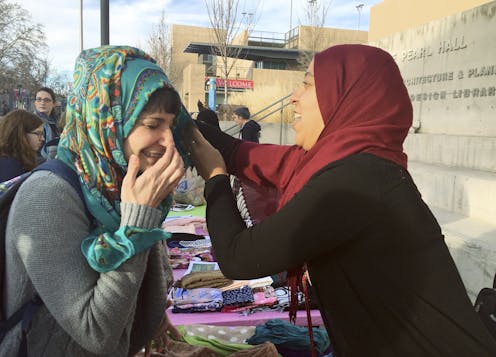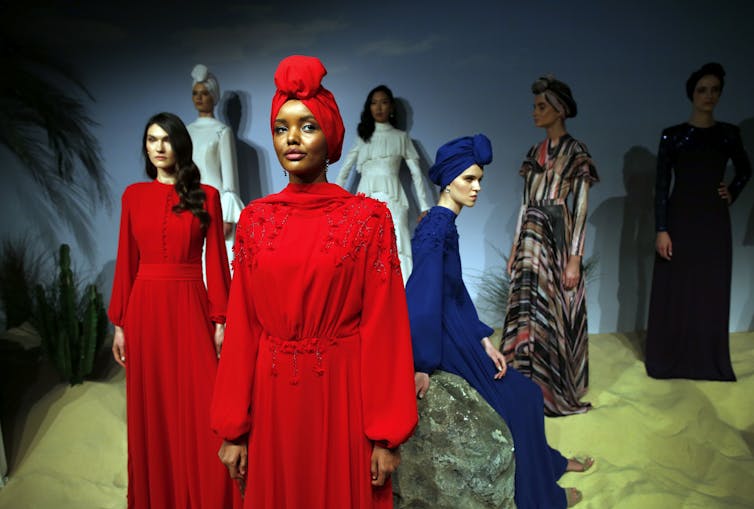Why Muslim women wear a hijab: 3 essential reads
For Muslim women, the hijab is not simply about religion. They may wear it for a variety of reasons. On World Hijab Day. women – Muslim and non-Muslim, are invited to experience this head covering.

In 2013, Nazma Khan – who immigrated to the United States from Bangladesh at age of 11 – started World Hijab Day. Growing up in the Bronx, New York, Khan experienced discrimination because of her headscarf – the hijab.
Celebrated on Feb. 1, the day is a “recognition of millions of Muslim women who choose to wear the hijab and live a life of modesty.” It invites women who do not usually wear a hijab – both Muslim and non-Muslim – to experience trying it. Khan believes the participation can “foster religious tolerance and understanding.”
Here are three pieces from our coverage that explain the many reasons why women wear a hijab and how it is part of a growing fashion industry.
1. An expression of identity
Caitlin Killian, a professor of sociology at Drew University, explains that there is disagreement among scholars about whether the religious text, the Quran, explicitly commands women to veil.
“Various passages,” she writes, “make reference to veiling by the prophet’s wives. But scholars disagree about whether these statements apply only to the prophet’s wives or to all Muslim women.”
Killian argues that the hijab can be a positive assertion of an identity. She explains that in countries that were colonized by the French or the British, Muslim women were encouraged to remove the veil and be more like European women. “Consequently, in North African and Middle Eastern countries, the veil became a symbol of national identity and opposition to the West,” she argues.
“Today, some women wear the hijab to signal pride in their ethnic identity,” she says. “This is more so for immigrants in Europe and the United States, where there has been an increase in Islamophobia.”
2. Modesty does not look the same
The hijab, and other modest Islamic clothing, show a wide range of styles and fashion across different cultures and countries. Liz Bucar, a scholar of philosophy and religion at Northeastern University found in her research work across Iran, Indonesia and Turkey that Islamic clothing also challenges some popular stereotypes about Islam. She found that the concept of modesty was not the same across all regions and that it had changed over time.
For example, she writes, in the most populous Muslim nation in the world – Indonesia – women did not wear head coverings or modest clothing until about 30 years ago. It was the same in Turkey, where, for much of the past century, “authorities discouraged Muslim women from wearing pious fashion, claiming these styles were ‘unmodern’ because they were not secular.”
Today’s local styles, she argues integrate fashion and modest clothing. In Turkey, she says, “local styles tend to be tailored closely to the body, with high necklines and low hemlines and complete coverage of the hair.”

3. Islamic fashion industry
Faegheh Shirazi, a scholar at University of Texas at Austin, explains the growing Islamic fashion industry. Nike, the well-known U.S. sportswear company, for example has introduced a sports hijab. As Shirazi says, Nike is not the first corporate brand to do so. She writes,
“Muslim fashion is a lucrative global industry with countries such as Indonesia, Malaysia and Turkey leading the way outside the Western countries. In 2010 the Turkish newspaper Milliyet estimated the global Islamic clothing market to be worth around US$2.9 billion.”
She finds that head coverings are often an important part of this fashion industry that is expected to reach $488 billion by 2019.
Editor’s note: This story is a roundup of articles from The Conversation’s archives.
Read These Next
From truce in the trenches to cocktails at the consulate: How Christmas diplomacy seeks to exploit s
World leaders like to talk up peace at Christmastime. But alongside the tales of seasonal breaks in…
As DOJ begins to release Epstein files, his many victims deserve more attention than the powerful me
Powerful men connected to Jeffrey Epstein are named, dissected and speculated about. The survivors,…
People are getting their news from AI – and it’s altering their views
Even when information is factually accurate, how it’s presented can introduce subtle biases. As large…





